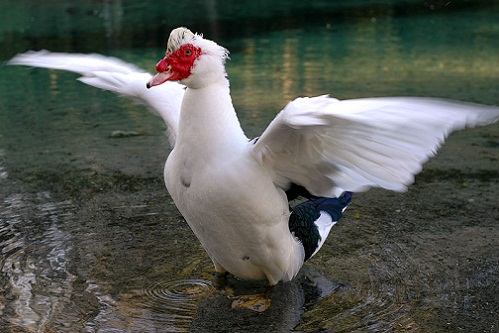|
Language is as infinitely fascinating as cuisine and the kitchens where they mingle are just plain fun. Take the word and bird: duck. A superficial survey of its use in our language gives us dead ducks, lame ducks, sitting ducks and odd ducks. We are admonished to get our ducks in a row and to duck down. “As a duck takes to water” is the go-to metaphor for easily and naturally, though water slips quickly off a duck’s back and when it rains, it’s lovely weather for ducks. Then there’s the duck test: If it looks like a duck, walks like a duck and quacks like a duck – it’s a duck. How would that test classify the DA haircut that left a pert little duck’s tail along the back of the neck. Perhaps because of it’s ungainly waddle on land, the water graceful duck has acquired many comical associations. Rubber ducks in particular have have been the target of many jokes. Then Sesame Street’s Ernie gave us all permission to love our bath toys. Since then, in our apparently worldwide defiant willfulness, the once maligned rubber duck has become the hero of Duck Derbies. The largest of many such derbies, held annually to raise funds for its works, is the Freestore Foodbank in Cincinnati. That one boasts 100,000 rubber contestants. Food writer Waverly Root guessed that it was the Chinese who first domesticated ducks. Duck was eaten regularly in pre-European North America, but it was available wild in such abundance that no one then bothered to domesticate it. All of the Peking ducks raised in the US today are the descendants of nine ducks imported to Long Island in 1893. By the mid 1960s, Long Island alone produced 7.5 million Peking ducks a year. Across the nation, farmers and other people who eat are again diverting some attention to a few of the older domesticated breeds, like Muscovy, Barbary and Mallards.
As a game meat duck has a deep rich flavor that can compliment as well as stand up to many other flavors. Inexplicably, duck on the table fell out of favor in the mid 20th C. Food trends tend to be cyclical and today the taste for duck is on the ascendancy. Modern methods and availability make it as easy as duck soup for home and professional chefs to combine bold and delicate flavors with this bird. In these virtual pages we’ve explored duck previously with Duck, Mushroom and Onion Stew, Black Lacquered Duck Breast and Duck Breast with Ginger Pear Glaze. Those recipes are available on the web site. Today’s recipe is Chinese Roasted Five Spice Duck. The Five Spice rub works just as well on the breasts alone. (See the note on the recipe for a list of the very best flavor affinities for duck.)
0 Comments
Leave a Reply. |


